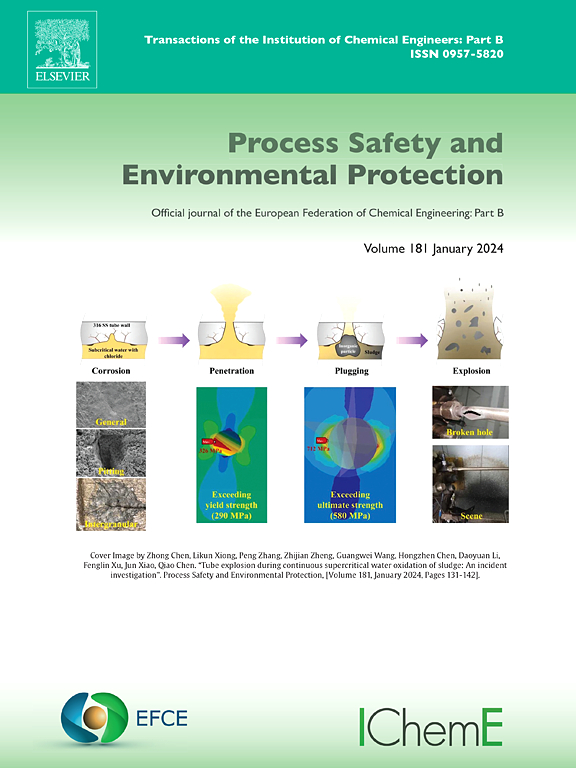多目标优化的高能效非均相变压精馏可持续回收废水中苯和叔丁醇
IF 6.9
2区 环境科学与生态学
Q1 ENGINEERING, CHEMICAL
引用次数: 0
摘要
叔丁醇生产过程中产生的废水通常含有苯和叔丁醇,但苯、叔丁醇和水可以形成一种三元共沸物和三种二元共沸物的混合物。该系统是压敏的,其三元相图具有非均相区。因此,建议改变操作压力或使用自然液-液分离的卧螺器对混合物进行分离。利用NSGA-II算法对这些分离过程进行多目标优化,找出最优方案。与变压蒸馏(PSD)和非均相共沸蒸馏(HAD)相比,非均相变压共沸蒸馏(HAPSD)工艺表现出更优越的性能。与PSD-2工艺相比,HAD工艺的年总成本(TAC)、火用破坏(exergy destruction)、总能耗(TEC)和CO2排放量分别降低了41.00 %、41.68 %、19.79 %和40.55 %,而HAPSD工艺的年总成本(TAC)、总能耗(TEC)和总能耗(CO2)分别降低了64.55 %、67.73 %、45.30 %和68.10 %。此外,HAPSD工艺结合了热泵技术和热集成技术,以最大限度地减少能源需求。结果表明,结合热集成和热泵的HAPSD工艺优于PSD工艺和HAD工艺。具体而言,与PSD工艺相比,其各项指标均有显著降低,TAC降低75.47 %,TEC降低88.94 %,气体排放降低88.10 %,火用破坏降低87.87 %。本文章由计算机程序翻译,如有差异,请以英文原文为准。
Sustainable recovery of benzene and tert-butanol from wastewater using energy-efficient heterogeneous azeotropic pressure-swing distillation with multi-objective optimization
The wastewater generated in the production process of tert-butanol usually contains benzene and tert-butanol, but benzene, tert-butanol and water can form a mixture which exhibits one ternary azeotrope and three binary azeotropes. This system is pressure-sensitive, and its ternary phase diagram features a heterogeneous region. Accordingly, changing the operating pressure or using a decanter for natural liquid-liquid separation are proposed for separating the mixture. The NSGA-II algorithm is utilized for multi-objective optimization of these separation processes to identify the optimal scheme. In comparison to the pressure-swing distillation (PSD) and heterogeneous azeotropic distillation (HAD), the heterogeneous azeotropic pressure-swing distillation (HAPSD) process demonstrates superior performance. Compared to the PSD-2 process, the total annual cost (TAC), exergy destruction, the total energy consumption (TEC) and CO2 emissions of the HAD process are reduced by 41.00 %, 41.68 %, 19.79 % and 40.55 %, respectively, while those of the HAPSD process are reduced by 64.55 %, 67.73 %, 45.30 % and 68.10 %, respectively. Additionally, the HAPSD process incorporates heat pump technology and heat integration technology to minimize energy demand. The results reveal that the HAPSD process combined with heat integration and heat pumps outperforms the PSD process and HAD process. Specifically, compared with the PSD process, it achieves significant reductions in various indicators: 75.47 % in TAC, 88.94 % in TEC, 88.10 % in gas emissions, and 87.87 % in exergy destruction, respectively.
求助全文
通过发布文献求助,成功后即可免费获取论文全文。
去求助
来源期刊

Process Safety and Environmental Protection
环境科学-工程:化工
CiteScore
11.40
自引率
15.40%
发文量
929
审稿时长
8.0 months
期刊介绍:
The Process Safety and Environmental Protection (PSEP) journal is a leading international publication that focuses on the publication of high-quality, original research papers in the field of engineering, specifically those related to the safety of industrial processes and environmental protection. The journal encourages submissions that present new developments in safety and environmental aspects, particularly those that show how research findings can be applied in process engineering design and practice.
PSEP is particularly interested in research that brings fresh perspectives to established engineering principles, identifies unsolved problems, or suggests directions for future research. The journal also values contributions that push the boundaries of traditional engineering and welcomes multidisciplinary papers.
PSEP's articles are abstracted and indexed by a range of databases and services, which helps to ensure that the journal's research is accessible and recognized in the academic and professional communities. These databases include ANTE, Chemical Abstracts, Chemical Hazards in Industry, Current Contents, Elsevier Engineering Information database, Pascal Francis, Web of Science, Scopus, Engineering Information Database EnCompass LIT (Elsevier), and INSPEC. This wide coverage facilitates the dissemination of the journal's content to a global audience interested in process safety and environmental engineering.
 求助内容:
求助内容: 应助结果提醒方式:
应助结果提醒方式:


